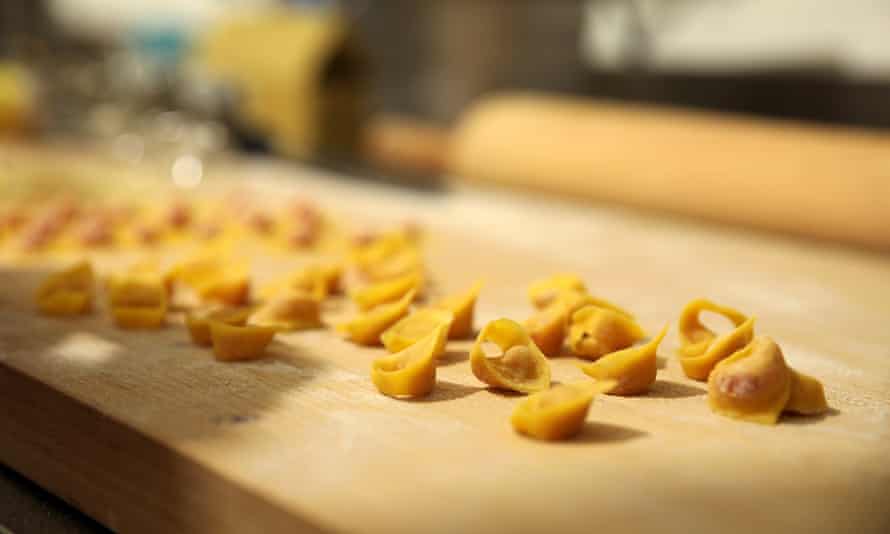Kevin Raub is an American travel journalist based in Bologna. He is co-author of more than 100 Lonely Planet guidebooks.
Food
Bologna is the capital of arguably Italy’s most important food region, Emilia-Romagna, a storied territory whose kitchens have given birth to a long list of specialities famous the world over. Lasagne, ragù, tortellini, mortadella, parmesan cheese and balsamic vinegar all hail from here.
At Pasta Fresca Naldi, a tiny shop/cafe west of the historic centre, pastaphiles line up for the hand-rolled specialities of owner Valeria and her team of nonne (grandmothers). Daily-changing offerings (from around €7) like tagliatelle with ragù or prosciutto and lemon; tortellini al pasticcio (baked with pork and cream); and gramigna alla salsiccia (curly pasta with sausage) will floor you. With just six stools inside, most people opt for a takeaway package.
For a sit-down experience, Trattoria Bertozzi regularly tops Bologna’s long list of excellent traditional restaurants. It’s almost a mile from the centre, far enough away to maintain its authentic ethos, with local dishes such as gramigna with cured pork, courgettes, saffron and shaved parmesan.

Inspiration
For five decades, until his death in 2012, Lucio Dalla was Italy’s most revered singer-songwriter. In 2019, his mesmerising home inside the 15th-century Palazzo Casa Fontana poi Gamberini, was opened to the public. Casa di Lucio Dalla (€15pp) is a wild ride through the eccentric mind of a musical genius, complete with a head-spinning potpourri of provocative bric-a-brac, personal artefacts and treasured art.
Neighbourhood
Bolognina (“Little Bologna”) sits behind the main train station and is a hub of working-class life. Bolognina is fairly short on attractions – they comprise a (free) museum about the mysterious 1980 Ustica plane crash, and the 19th-century Sacred Heart church with its huge cupola – but long on personality. It’s an up-and-coming, multicultural neighbourhood of markets, ethnic eateries and innumerable accents. Gentrification hasn’t quite dug its heels in here, but streets such as Via Luigi Serra (home to the fantastic, and fantastic value, Trattoria di Via Serra; hip bar/cafe Fermento; artisanal bakery Forno Brisa and organic gelateria Stefino) give a sense of Bolognina’s direction of travel, and reward those who venture out of the centre.

Green space
No Bologna park fulfils green-space hankerings like Giardini Margherita, a 26-hectare expanse inaugurated in 1879 and inspired by English landscape gardens. The city’s former municipal greenhouses have been repurposed into one of Bologna’s coolest venues, home to Vetro (for drinks and vegan bites) and Le Serre (with co-working spaces exhibitions and cultural events). Be it for happy hour or an hour or two of alfresco work, it’s easy to laze away an afternoon here.
Nightlife
Via del Pratello is Bologna’s famous nightlife street, but for a bit more character with your cocktails, set a date with Davo, Don, Jack and Ricky at Ruggine on Vicolo Alemagna. Four friends from various corners of northern Italy opened this cocktail bar on a narrow, glow-orange alley 450 metres from Piazza Maggiore. You won’t find Campari, Aperol or fancy garnishes here, but locally driven craft mixology.
To tap into Italy’s excellent craft beer scene, head a short way west to Il Punto, which has an array of ales on draught (including one hand-pump), with a focus on local birra artigianale. Fans of sours and wild ales should try a tipple at Ca’ del Brado, a top-notch craft brewery a few miles south of the city centre.
Stay
Close to the old town, art historian Maria Ketty runs the charming Bologna nel Cuore, a B&B with two doubles and two one-bedroom apartments, offering bright interiors, high ceilings, colourfully tiled bathrooms and very generous breakfasts. Doubles from €125, bolognanelcuore.it





